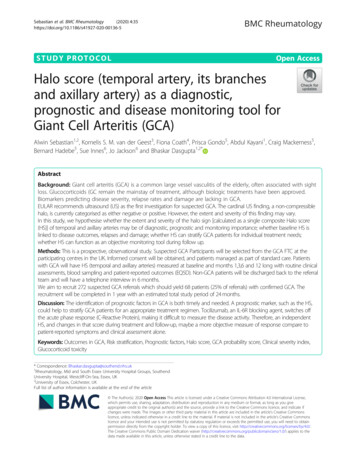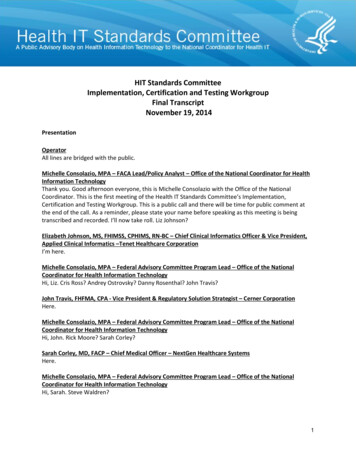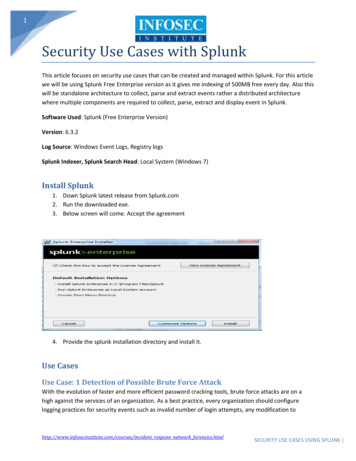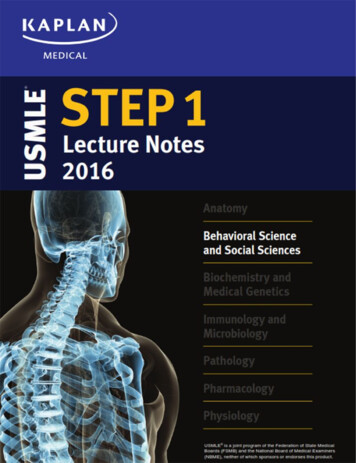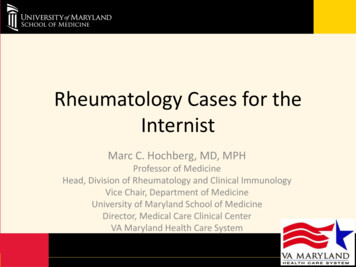
Transcription
Rheumatology Cases for theInternistMarc C. Hochberg, MD, MPHProfessor of MedicineHead, Division of Rheumatology and Clinical ImmunologyVice Chair, Department of MedicineUniversity of Maryland School of MedicineDirector, Medical Care Clinical CenterVA Maryland Health Care System
Objectives To present and discuss three cases thatrepresent the most common reasons forreferral to my academic rheumatologypractice at both the University of Marylandand Baltimore VA Medical Center.
Case 1: History 45-year-old woman who presents for evaluationof polyarticular joint pain of several yearsduration. She admits to AM stiffness lasting 1 hour, gelphenomenon, but denies joint swelling orredness. Review of systems is positive for difficulty fallingasleep, difficulty staying asleep, snoring, fatigueand diffuse myalgias; pertinent negatives includelack of fever or weight loss.
Case 1: History There is no h/o sicca symptoms, rash, mucosalulcers, Raynaud phenomenon or Lyme disease. Family history is non-contributory. Social history is positive for modest alcoholconsumption (average 4 drinks per week), formersmoker, no illegal drug use. She lives in BaltimoreCity and currently works as an administrativeassistant.
Case 1: Physical Examination Normal vital signs No evidence of active or chronic synovitis,joint effusions or deformity. Normal muscle strength. Tender at 14/18 “tender points.” Remainder of examination, includingneurologic exam, is within normal limits.
Fibromyalgia: Treatment Non-pharmacologic modalities– Patient education, good sleep hygiene, cognitivebehavioural therapy and aerobic exercise program;consider acupuncture, tai chi and/or yoga Pharmacologic modalities– Amitriptyline or cyclobenzaprine followed byduloxetine or milnaciprin, pregabalin or acombination of the above– Avoid opioid analgesics!
2017 EULAR Management Recommendations. 2017 by BMJ Publishing Group Ltd and European League Against RheumatismG J Macfarlane et al. Ann Rheum Dis 2017;76:318-328
Case 1: Questions
Case 2: History 45-year-old woman who presents for evaluationof polyarticular joint pain of several monthsduration. She admits to AM stiffness lasting 1 hour, gelphenomenon and joint swelling with difficultyperforming her usual daily activities. Review of systems is positive for fatigue,depressed mood, low grade fever, anorexia andweight loss.
Case 2: History Positive for h/o sicca symptoms; however, shedenies rash, mucosal ulcers, chest pain, muscleweakness or Raynaud phenomenon. Family history is positive for RA in her mother. Social history is positive for modest alcoholconsumption (average 4 drinks per week), currentsmoking, but no illegal drug use. She lives inBaltimore County and currently works as anadministrative assistant.
Case 2: Physical Examination Normal vital signs Combination of both active and chronic synovitisinvolving all PIP and MCP joints of both hands and bothwrists as well as tenderness across MTP joints of thefeet bilaterally. Normal proximal muscle strength; however, gripstrength is reduced bilaterally. No subcutaneous nodules or skin rash Remainder of examination, including neurologic exam,is within normal limits.
16
18
Case 2: Laboratory Evaluation CBC with differentialChemistry profileAcute phase reactantsSerology– Rheumatoid factor– Anti-citrullinated peptide antibodies (ACPA)
Case 2: Imaging Evaluation Definite– Plain radiographs of affected joints Possible– Color Doppler ultrasound– Magnetic resonance imaging
22
RA: Approach to Management Refer to rheumatologist! All patients with active RA should receive adisease-modifying antirheumatic drug (DMARD) All patients should receive non-pharmacologicmodalities including patient education, OT/PT NSAIDs and glucocorticoids are adjunctiveagents for control of symptoms
Case 2: Questions
Case 3: History 45-year-old man who presents for evaluation ofpolyarticular joint pain and swelling involving the leftfoot/ankle, right knee and wrist of several weeksduration. He has a h/o recurrent episodic monoarthritispreviously involving the big toe bilaterally, left ankleand right elbow. These were previously treated withOTC NSAIDs; he has never had a joint aspirate or beentreated with colchicine or urate lowering therapy. Review of systems is positive for low grade fever andanorexia.
Case 3: History Positive for h/o hypertension treated with HCTZand lisinopril, and hyperlipidemia treated withsimvastatin. Family history is positive for kidney stone andgout in his father. Social history is positive for moderate alcoholconsumption (average 10 drinks per week),current smoking, but no illegal drug use. He livesin Baltimore County and formerly worked atBethlehem Steel.
Case 3: Physical Examination Normal vital signs Combination of active synovitis involving left footand ankle, right knee and right wrist withwarmth, tenderness and soft-tissue swelling;right knee effusion present with positive bulgesign. Subcutaneous nodule in right olecranon bursa. Remainder of examination is within normal limits.
Correct Nomenclature Gout is a chronic inflammatory arthritis that resultsfrom monosodium urate (MSU) crystal deposition intissues or joints resulting from supersaturation of uricacid in extracellular fluids Gout is a disorder of uric acid metabolism Hyperuricemia is defined as serum uric acid 2 SDabove the mean ( 7.0 mg/dL for men, 6.0 mg/dL forwomen) Hyperuricemia is a necessary but not sufficientprecursor to gout
Gout: Stages Asymptomatic hyperuricemiaAcute episodic monoarthritisIntercritical goutChronic polyarthritis, often with tophaceousdeposits
Case 3: Evaluation Laboratory tests– CBC with differential– Chemistry profile, including serum uric acid– Acute phase reactants Imaging– Plain radiography– Ultrasonagrapy (double contour sign)– Dual-energy CT
Gout: Treatment of Arthritis Treat acute/chronic arthritis– Colchicine– NSAIDs– Glucocorticoids– IL-1 inhibition
Gout: Prevention of Recurrent Attacks Oral colchicine Urate lowering therapy– Xanthine oxidase inhibition Allopurinol Febuxostat– Uricosuric agents Probenecid Lesinurad (ZurampicTM) specific URAT1 inhibitor
Case 3: Questions
Choosing Wisely: Rheumatology Don’t test ANA sub-serologies unless the ANA ispositive in a clinically significant titer Don’t test for Lyme disease without an exposurehistory and appropriate exam findings Don’t perform MRI of the peripheral joints tomonitor inflammatory arthritis Don’t prescribe biologic DMARDs for RA before atrial of MTX or other conventional DMARDAmerican College of Rheumatology. Released February 21, 2013.
Rheumatology Referral Guidelines Evaluation of patients with unclear diagnoses Evaluation and management of patients with– Inflammatory arthritis– Systemic autoimmune rheumatic diseases Connective tissue diseases and vasculitides Diagnostic or treatment plan for rheumaticmanifestations of other primary diseasesApproved by ACR Board of Director, August 2015 (modified by MCH)
Thank you for your kind attention.
Feb 21, 2013 · 2017 EULAR Management Recommendations. 2017 by BMJ Publishing Group Ltd and European League Against Rheumatism G J Macfarlane et al. Ann Rhe




